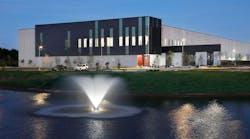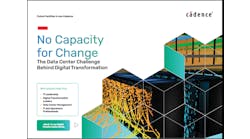You can go big or go home. Or, if you’re IO, you do both.
The colocation and cloud specialist is planning a huge expansion of its data center campus in Phoenix, the city its leadership team has called home since 1999. IO has bought land next to its huge Phoenix facility, and plans to build an even larger modular data center.
The three-story building will feature 240,000 square feet on each floor, for a total of 720,000 square feet of space. As it is filled, the new data center will grow to 100 megawatts of capacity.
The IO project forges a new frontier for factory-built data centers, going vertical to gain additional scale for the “modular colo” offering that IO has deployed around the globe.
It also reinforces a trend we’ve been highlighting here at Data Center Frontier – the super-sizing of the data center campus. Upon completion, IO will operate more than 1.2 million square feet of data center space on its Phoenix campus.
When IO opened the doors of its Phoenix data center in 2009, it was hard to imagine that the 530,000 square foot building would be filled anytime soon. Now it is approaching capacity, prompting IO to acquire nine acres of land next door.
The Phoenix campus “has been a fantastic success,” said Tony Wanger, the president of IO. “We’ve filled the entire building. You don’t ever want to run out of inventory, so the ability to expand in Phoenix is a big, big deal for us.”
Factory-Built Data Centers Go Global
The new facility will help IO meet growing demand for its colocation and cloud services. The company has grown beyond its initial base of operations in the Phoenix area (which also includes a data center in Scottsdale) with a global expansion that now includes data centers in New Jersey, Ohio, London and Singapore. The infrastructure supporting IO’s footprint is a suite of modular data centers, which are designed and manufactured in Chandler, Ariz. by industrial infrastructure provider BASELAYER.
IO has been a pioneer in the market for modular data centers. In 2008, IO created an internal division to develop hardware and software products to support its expanding footprint. These pre-fabricated products have evolved rapidly, offering flexible designs that can create an enclosed data hall that looks and feels like traditional data center space. In 2014, IO spun off BASELAYER to handle global sales of module data centers (BASELAYER Anywhere) and infrastructure management software (BASELAYER RunSmart OS) to large enterprises. IO continues to focus on its core colocation business.
An overhead view of a data hall filled with modules at the IO Phoenix data center. (Image: IO)
With most of its previous facilities, IO has retrofitted an existing structure. The new Phoenix data center will be a “greenfield” project, and can be customized to support a multi-story modular colocation operation.
Wanger said IO expects to break ground this year, and plans a structurally robust three-story building with a rooftop equipment yard. Data center modules will be manufactured at the BASELAYER facility, and make a 15-mile truck ride to the IO Phoenix site, where they will enter the building on the first floor, and be raised to the second or third floors via a large elevator. The 42-foot long modules are moved using “air skates” that use compressed air to raise heavy loads (similar to a hovercraft) and allow one or two staffers to move modules as heavy as 20 tons.
The Benefits of a Cloud Campus
“Building from scratch affords us a lot of flexibility,” said Wanger. “We’re already thinking about our loading plan, and we can leave plenty of room for turning radius. We’re optimizing for module yield.”
Wanger says that the multi-story design will allow the new data center to house more modules than IO’s initial Phoenix building, even though it has a smaller physical footprint. Scale matters to IO, which operates a 1 million square foot facility in Edison, New Jersey.[clickToTweet tweet=”IO President Tony Wanger: The ability to expand in Phoenix is a big, big deal for us.” quote=”IO President Tony Wanger: The ability to expand in Phoenix is a big, big deal for us.”]
That’s why IO is embracing the multi-building cloud campus, an approach pioneered by hyperscale players like Google, Microsoft and Facebook, as well as huge data center REITs like Digital Realty and DuPont Fabros. The campus solution enables companies to find the very best places to build a data center, and acquire enough land to provide years of runway for growth.
The benefits of this approach can be seen at IO Phoenix, where there are already 25 connectivity providers on the property. An existing substation, which abuts the expansion land, already brings 82MVA of electrical power to the site. That capacity can be expanded to 123 MVA, and IO has the ability to build a second substation and add a utility feed as the project grows.
A Legacy in Phoenix
The team of Wanger, IO CEO George Slessman and BASELAYER CEO Bill Slessman has a long history in the Phoenix market. In 1999, they developed the city’s first major telecom hotel, the Downtown Phoenix Technology Exchange at 120 East Van Buren Street. In 2006, that facility was acquired by Digital Realty for $175 million.
In 2007, the Slessmans and Wanger formed I/O Data Centers (now just IO) and brought its first facility online in Scottsdale. Two years later, they acquired the huge, power-rich site for IO Phoenix, which was built to house the bottling operations of LeNature’s Beverages, which never fully occupied the building before filing for bankruptcy.
IO transformed the massive building into a data center, with early phases using a raised-floor design before IO went all-in on modular design. The company now has more than 400 customers in Phoenix, ranging from cloud customers to tenants like LexisNexis and telco CenturyLink, which leased 9 megawatts at IO Phoenix last year.
Wanger sees this growth as an affirmation of IO’s decision to use modular designs as flexible building blocks for scalable infrastructure. “Now virtually everyone in the industry uses standardized designs and pre-fabricated products,” said Wanger.
IO still likes to go big. In looking to its next big adventure, the IO team has to look no farther than next door.
And for further coverage, check out Data Center Frontier’s page dedicated to the Phoenix Data Center Market, that will provide the latest stats and info on this quickly growing area that is becoming a leading market in the colocation industry.






